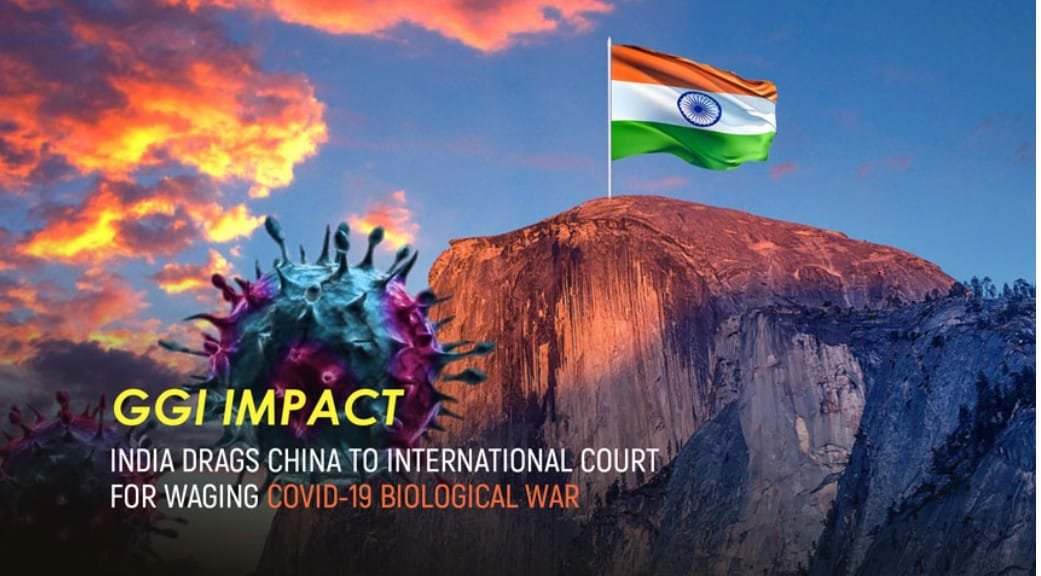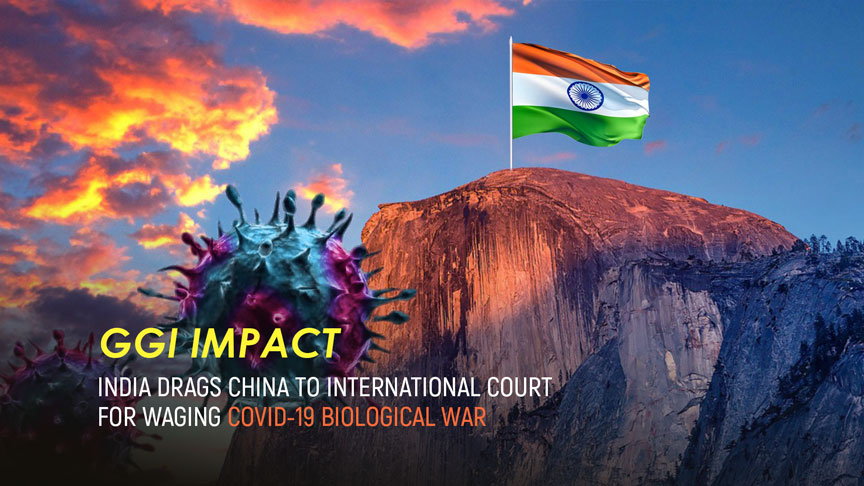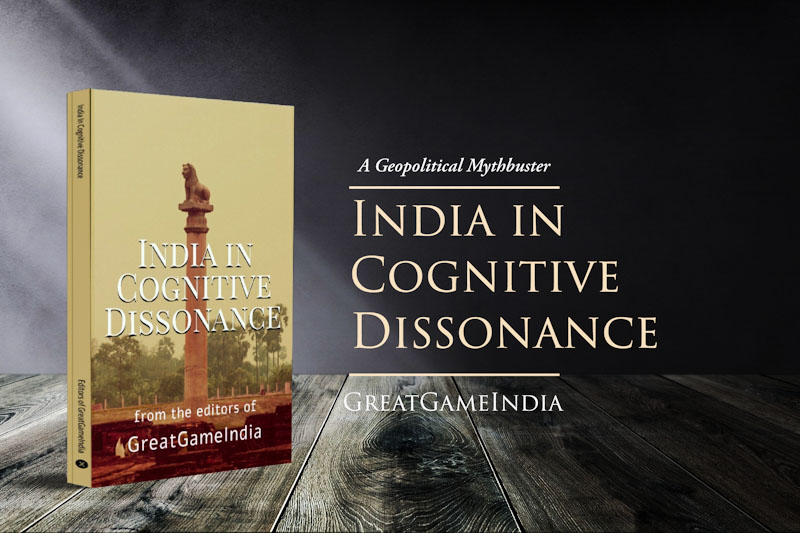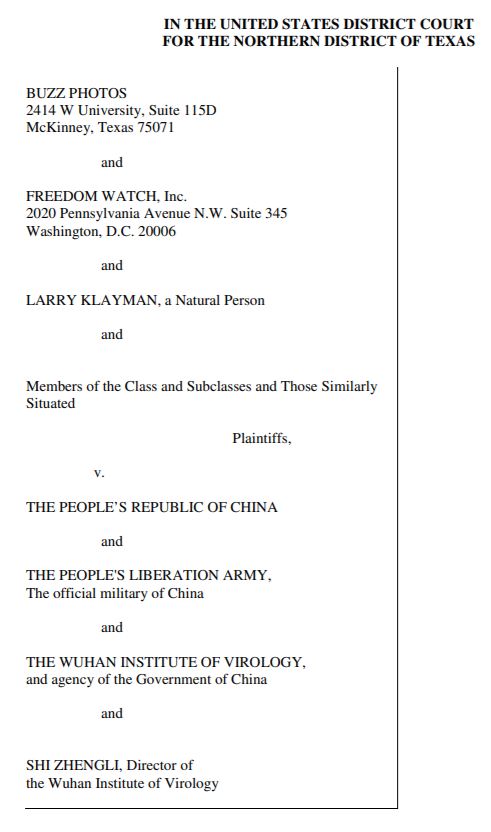India Accuses China of Bio-War Attack with CV19, Files Court Case

As a direct impact of extensive GreatGameIndia reporting on the sinister aspect of Coronavirus being manufactured as a biological weapon, now India has dragged China to international court for waging COVID-19 War. India’s complaint to the United Nations Human Rights Council seeking compensation from China specifically presents as evidence GreatGameIndia‘s report on how Chinese biowarfare agents stole Coronavirus from a Canadian lab and weaponized it at Wuhan Institute of Virology.
In addition to the Indian complaint, a $20 trillion lawsuit has also been filed against China for waging a Biological war in Texas Federal Court, alleging that it unleashed the coronavirus as a bioweapon upon the world.
GGI has come under massive attack for reporting these stories from so-called fact-checker organisations like NewsGuard who themselves are funded by Bill Gates to clear their name. The mainstream media owes GGI a big apology for slandering our name, failing to ask the basic question of ‘conflict of interest’.
EXCLUSIVE: Coronavirus Bioweapon – How China Stole Coronavirus From Canada And Weaponized It (watch here Visualizing The Secret History Of Coronavirus)
Watch the exclusive interview of Bioweapons Expert Dr. Francis Boyle on Coronavirus Biological Warfare blocked by the Deep State India Drags China To International Court For COVID-19 War
India Drags China To International Court For COVID-19 War
 India Drags China To International Court For COVID-19 War
India Drags China To International Court For COVID-19 War
The Complaint
The International Council of Jurists (ICJ) and All India Bar Association have moved the United Nations Human Rights Council seeking compensation from China for “surreptitiously developing a biological weapon capable of mass destruction.”

The complaint was penned by senior advocate Adish C. Aggarwala, the Chairperson of All India Bar Association and President of International Council of Jurists, in the backdrop of the spread of deadly coronavirus, which has claimed thousands of lives across the world.
“It is humbly prayed that the UNHRC may be pleased to enquire and direct China and to adequately compensate international community and member states, particularly India, for surreptitiously developing a biological weapon capable of mass destruction of mankind,” Aggarwala stated in the complaint.
The advocate demanded remuneration from China for inflicting serious physical, psychological, economic and social harm on the world. Aggarwala also pointed out the effects of the pandemic on the Indian economy, the imbalance in demand and supply of commodities and migration of marginalized people.
“The economic activity of the country is put on hold, in turn causing a huge dent on the local economy of the country as well as in general, the global economy,” the complaint added.
The complaint further claimed that China meticulously hatched a conspiracy to spread the coronavirus in the world and violated provisions of International Health Regulations (IHR), International Human Rights and Serious Violations of International Humanitarian Laws and UDHR clauses.
“It remains a mystery as to how the virus has not spread to all provinces of China but at the same time, has spread to all countries in the world. The speculation only increases the likelihood of the COIVD-19 being a carefully assembled biological weapon, aimed at crippling major countries in the world leaving only China as the beneficiary,” the complaint pointed out.
The complainant further claimed that the virus was developed in the Wuhan Virology Lab from where it was carefully deployed to affect a miniscule 0.001% of the Chinese population.
He said that the neighboring country deployed the coronavirus virus in a bid to control the economy of the world by buying up stocks from countries that are on the brink of economic collapse.
The Chinese government had deliberately censored information and hid the early warnings given by Dr. Li Wenliang, who was, in fact, reprimanded and initially punished by local authorities in China, he said.
EXCLUSIVE#Coronavirus Bioweapon Thread
How China Stole Coronavirus From Canada And Weaponized Ithttps://greatgameindia.com/coronavirus-bioweapon/ …
“The government also did not sufficiently contain and curb the travel of infected persons from further contaminating the world.”
GGI Impact
It complaint states that the Chinese government has meticulously planned the execution and spread of the Novel Coronavirus and the same can be inferred in the way China has taken regard of the situation as also of the curious case of the spread of the virus all over the world. As pointed earlier, it remains a mystery as to how the virus has not spread in all provinces of China but at the same time, has spread to all countries in the world.
The complaint further presents as evidence findings of GreatGameIndia‘s investigation cited by India’s national daily on how Chinese biowarfare agents stole Coronavirus from a Canadian lab and weaponized it at Wuhan Institute of Virology.
A group of Chinese scientists in Canada were accused of spying and were stripped of their access to Canada’s National Microbiology Lab, sometime in August 2019 and the said lab is known to contain some of the world‟s deadliest pathogens. These scientists then were sent to a High security biochemical Wuhan Lab, which is one of the world‟s most heavily guarded labs. That these scientists later developed the COVID-19 virus and released it to the outside world somewhere in the early days of December 2019 in Wuhan, from where the virus spread.
Further the complaint also blasts the mainstream media’s agenda for suppressing these facts being raised by prominent experts and influential personalities worldwide.
The purpose of developing such a potent and deadly virus remains a secret. However, there are solid evidences to show that the Chinese government intends to utilize the same to take control of the world’s economy. The hypothesis of biological warfare behind the global pandemic had already been raised by Russian experts some weeks ago.
Like any opinion that is slightly different from the official version of Western governments and their media agencies, the thesis was ridiculed and accused of being a “conspiracy theory”. However, as soon as the official spokesman for the Ministry of Foreign Affairs of the second largest economic power on the planet publishes a note attesting to this possibility, it leaves the sphere of “conspiracy theories” to enter the scene of public opinion and official government versions.
In addition to the Indian complaint to the United Nations Human Rights Council, a $20 trillion lawsuit has also been filed against China for waging a Biological war, alleging that it unleashed the coronavirus as a bioweapon upon the world by U.S. lawyer and conservative activist, Larry Klayman, his Company Buzz Photos and his group Freedom Watch. First page of the class action lawsuit brought by Larry Klayman against China for waging a Biological War. Find the full document here Source: Freedom Watch
First page of the class action lawsuit brought by Larry Klayman against China for waging a Biological War. Find the full document here Source: Freedom Watch
 First page of the class action lawsuit brought by Larry Klayman against China for waging a Biological War. Find the full document here Source: Freedom Watch
First page of the class action lawsuit brought by Larry Klayman against China for waging a Biological War. Find the full document here Source: Freedom Watch
In the lawsuit, Klayman argued that because China had already agreed by Biological Weapons Convention treaty to outlaw such weapons c. November, 1984, these actions cannot be official governmental actions of the People’s Republic of China and therefore, China cannot claim legal immunity from the class action lawsuit.
Klayman added in a statement, “There is no reason why the American taxpayer should, contrary to the establishment in Washington, D.C., have to pay for the tremendous harm caused by the Chinese government. The Chinese people are a good people, but their government is not and it must be made to pay dearly.”
Klayman is seeking $20 trillion in damages and has called for affected Americans to sign up at his website Freedom Watch USA and become part of the class action lawsuit. The case has been filed in a Texas Federal Court.
Klayman is not the only one calling out China’s Biological Warfare activities. Chinese mishandling of the virus has attracted global criticism and numerous prominent personalities have come forward urging the international community to conduct an investigation into these serious matter and take action.
As China’s Virus Cases Reach Zero, Experts Warn of Second Wave
China will be test case for what happens after lockdown lifts
New virus won’t fade out like SARS as it’s harder to detectWe’re tracking the latest on the coronavirus outbreak and the global response. Sign up here for our daily newsletter on what you need to know.
China has no new infections of the coronavirus domestically for the first time since the start of a crisis that has sickened over 80,000 Chinese people. But what could be a sign the country has defeated the fatal pathogen is likely to just be a temporary reprieve.
While the outbreak’s epicenter has shifted to Europe, where there are now more cases being reported daily than at the height of China’s crisis, epidemiologists warn that the Asian giant could face subsequent waves of infections, based on patterns seen in other pandemics.

Medical staff wave goodbye to a recovered coronavirus patient at the Red Cross Hospital in Wuhan on March 16.
Photographer: AFP via Getty Images
The nature of this particular virus also raises the risk of a resurgence. The coronavirus is harder to detect and lingers longer than the one that caused Severe Acute Respiratory Syndrome in 2003, which infected 8,000 people before fading out. That will make future waves of the new pandemic more difficult to prevent.
As other countries wrestle with how far to close down civic life, they’ll be watching China, where the virus first emerged last December, to see what happens when it lifts the harsh lockdowns and social distancing measures that have helped curb the its outbreak.
Spread of Coronavirus Has Slowed in Asia
Europe, U.S. seeking ways to reduce increase in infections
Sources: World Health Organization, NHC and Bloomberg reporting as of March 17, 2020 18:00 GMT
Note: WHO reporting began on Jan. 21. Chart shows only the first 30 days with more than 100 cases for each area.
There were no new cases reported Thursday in Wuhan, the city in central Chinese Hubei province from which the outbreak began. There have been no new cases in the rest of the country for seven days, a dramatic plunge from the height of an outbreak that killed more than 3,000, and caused a historic economic contraction.
China’s measures -- which included a massive quarantine of Hubei province, a region of 60 million people -- had success in interrupting transmission in the rest of the country, said David Heymann, a professor of infectious disease epidemiology at the London School of Hygiene & Tropical Medicine.

“The concern is what will happen after they end these measures.”
Even if there had been many times more coronavirus cases than officially reported by the Chinese government, less than 1% of the population would have been infected in its first wave, “leaving most people in China susceptible,” said Raina MacIntyre, a biosecurity professor at the University of New South Wales in Sydney.
“The global pandemic will not be contained until we have a vaccine, or most of the population is infected,” she said.
Imported Cases
There have been 189 cases of infection in total among travelers entering China. In Beijing, all inbound visitors must now spend 14 days after arrival in specified quarantine locations, the cost of which they must foot themselves. The Chinese capital is also likely to order flights to stop in nearby cities to test passengers before they can journey on to Beijing.
Financial hub Shanghai and manufacturing center Guangdong are also tightening restrictions.
“It’s going to keep burning. The virus is still out there,” said Michael Osterholm, director of the Center for Infectious Disease Research and Policy at the University of Minnesota. “We expect it to leak back in from the rest of the world.”
And while China has officially stated that it believes the peak of the current outbreak is over, its top scientists are still struggling to predict how the virus will behave from here.
“No one knows whether the virus will disappear ultimately, or will it persist like flu and become prevalent intermittently, or will it be like hepatitis B that resides in people without sufficient immunity and spreads to others in that way?” said Wang Chen, the dean of Peking Union Medical College, in an interview with Xinhua on Friday.
He called for serological testing -- which identifies anti-bodies in a patient’s blood to see if they’ve been exposed to the virus -- to monitor how immunity is generated so as to understand the pathogen’s transmission patterns.
Spreads Too Easily
Beyond the challenges of stopping a pandemic in an inter-connected world with frequent travel, many researchers have already concluded that it will not be eliminated like its cousin that caused SARS.
In the early days of infection, when people have not yet developed symptoms to realize they are sick, high amounts of the virus are already present in their blood and they are transmitting it to others, said John Mackenzie, an emeritus professor of infectious diseases at Curtin University in Perth, Australia.
Early on in an infection, it’s also possible that a person could test negative even if they have the virus, according to the Centers for Disease Control and Prevention.
These stealthy qualities make complete elimination difficult, if not impossible, without a vaccine -- a product that drugmakers have said will take until next year to develop.
Very different factors were at play in the SARS pandemic, where those who were infected weren’t contagious until they were visibly very sick. That’s also the case for viruses that cause Ebola and MERS.
“With SARS, there was no transmission during incubation or during the early symptomatic phase, and so control was relatively easy once we knew the transmission dynamics,” said Mackenzie.
Isolating sick patients ultimately arrested transmission, and health authorities were able to stamp out the pathogen without a vaccine or cure being developed. Ebola and MERS also do not spread easily, and most infections occurred through contact with the virus’s animal host or in hospitals when caring for infected patients.
In contrast, the pandemics that began in 1889 and 1918 -- caused by influenza viruses that had similar levels of contagiousness to the coronavirus -- had three waves of infections, with the later waves more lethal than the first.
In 1918, three waves hit in quick succession within the space of a year, with the latter two waves accounting for most of the 50 million total death toll.
While researchers do not know for sure why later waves were more deadly, a phenomenon known as “antigenic drift,” in which small, natural changes build up in a virus’s genetic make-up over time, can change the pathogen enough to make it more harmful to human beings.
“This coronavirus is more comparable to influenza,” said Ben Cowling, a professor of epidemiology at Hong Kong University, who said it might take two months for fresh cases to emerge in China. “It spreads too easily, and most parts of the world don’t have the ability like China to do containment and control to get rid of it.”
Long Road
The U.S. and European countries are focusing now on trying to “flatten” the curve -- spreading out infections over a longer time period to reduce the strain on the health system. What containment will look like in the long term depends on what we learn about the virus, said Dorit Nitzan, coordinator of health emergencies for the WHO’s European office.
She cautioned against counting on protection from herd immunity -- when the majority of a population is no longer susceptible to a virus because they’ve either been vaccinated or have already contracted it and recovered -- as there are still too many unknowns.
“It’s a new virus, and we have to learn it,” Nitzan said in a press briefing on Tuesday. It is still unclear how long patients who recover will be immune, or whether the virus will change frequently like the seasonal flu, she said.
In one of the first studies to model the dynamics of the coronavirus once the current pandemic is over, a team from the Harvard T.H. Chan School of Public Health projected that future outbreaks will probably recur in the wintertime. This finding was based on factors like seasonality, the duration of immunity and the strength of cross-immunity to and from other human coronaviruses.
With some breathing space for now, China must pivot from fighting the virus to finding a way to live with it.
“The virus is constantly growing and changing, which makes total containment impossible,” said Chan Kung, health policy analyst at Beijing-based consultancy Anbound, who advised the local government during the SARS outbreak. “The only way to go forward is to understand it, adapt to it and make sure the virus doesn’t cause dramatic outbreaks so that the existing healthcare system can handle it.”




No comments:
Post a Comment